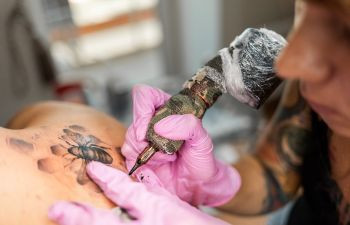Getting a tattoo is an exciting way to express yourself, but for some, the healing process can lead to unexpected complications. If you’re considering ink, it’s crucial to be aware of keloid scars and how they can relate to tattoos. Keloid disorder is a genetic condition that makes individuals prone to developing keloids, raised scars that grow beyond the original wound site. Since tattooing involves repeatedly puncturing the skin with needles, it can unfortunately be a trigger for keloid formation.
 A tattooist at work applying a tattoo, highlighting the needle and ink application process.
A tattooist at work applying a tattoo, highlighting the needle and ink application process.
What Exactly is a Keloid Scar?
Keloid scars are more than just typical scars; they are characterized by their excessive growth and prominence. They are composed of collagen and fibroblasts, which are essential for skin repair. However, in keloid formation, these cells overreact to skin injury. Keloids are essentially an overgrowth of scar tissue.
These scars can arise from various skin traumas, including surgery, acne, burns, piercings, insect bites, and notably, tattoos. The tattooing process, by its very nature, creates thousands of tiny punctures in the skin to deposit ink. This repetitive injury can sometimes trigger keloid formation in susceptible individuals. Keloids are easily recognizable as thick, raised bumps that extend beyond the initial wound. They often have a smooth, shiny surface and can be reddish-brown in color. Some keloids can also cause discomfort, including pain or itching.
Tattooing and Keloid Scarring: Is There a Link?
While tattoos themselves don’t cause keloid disorder, the skin injury from tattooing can certainly initiate keloid development in those who are predisposed. It’s important to understand that keloids are not a typical tattoo complication but rather a reaction by the skin in individuals with a keloid tendency. Poor aftercare or infection can exacerbate skin trauma, but the primary factor is the individual’s genetic predisposition to keloid scarring.
If a keloid scar forms over a tattoo, it can significantly distort the artwork, often obscuring the design completely beneath the raised scar tissue. This can be a disheartening outcome for someone who got a tattoo for aesthetic reasons.
Can You Get a Tattoo Without Keloids? Understanding Your Risk
For individuals with a known history of keloid scarring, either personally or within their family, the risk of developing keloids from tattoos is significantly higher. It’s generally recommended to avoid tattoos and piercings if you fall into this category. If you’ve experienced keloids from minor skin injuries in the past, it’s a strong indicator that you may develop a Keloid Scar Tattoo.
However, even with a predisposition, there are factors to consider. A skilled and experienced tattoo artist will work to minimize skin trauma. Tattoo needles are designed to penetrate only the upper layers of the skin, not reaching the deeper dermis where keloid scarring is more likely to occur. Choosing tattoo locations with less muscle and movement may also reduce the risk, as constant skin motion can sometimes contribute to scar tissue overgrowth. A cautious approach is to start with a small tattoo in a less visible area to observe how your skin heals before committing to larger or more prominent designs.
What to Do if a Keloid Scar Develops on Your Tattoo
If you suspect you are developing a keloid scar on your new tattoo, it’s important to seek professional advice. While the original article mentions a specific clinic, for readers of tattooat.com, the best course of action is to consult a dermatologist or a specialist in scar treatment. They can properly diagnose the scar and recommend appropriate treatment options. Early intervention is often more effective in managing keloid scars.
In conclusion, while tattoos can be a source of keloid scars for susceptible individuals, understanding the risks and taking preventative measures can help minimize complications. If you are concerned about keloid formation, especially with a personal or family history, careful consideration and professional consultation are essential before getting a tattoo.
